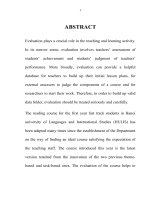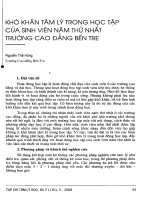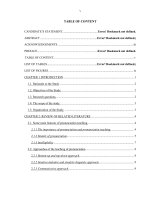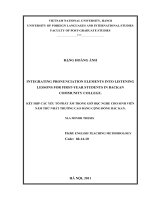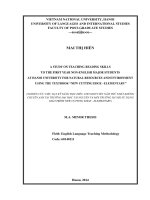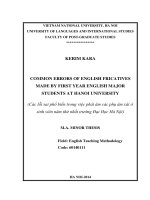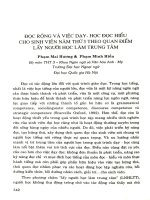Những thành tựu mới trong Anh ngữ học có thể ứng dụng vào việc giảng dạy kỹ năng đọc hiểu cho sinh viên năm thứ nhất trường Cao đẳng Công nghệ Vietronics
Bạn đang xem bản rút gọn của tài liệu. Xem và tải ngay bản đầy đủ của tài liệu tại đây (592.35 KB, 49 trang )
VIETNAM NATIONAL UNIVERSITY, HANOI
UNIVERSITY OF LANGUAGES AND INTERNATIONAL STUDIES
FACULTY OF POST-GRADUATE STUDIES
***
NGUYỄN CHÍ DŨNG
ADVANCES IN ENGLISH LINGUISTICS EMPLOYABLE
FOR THE TEACHING OF READING COMPREHENSION
TECHNIQUES TO FIRST YEAR STUDENTS
AT VIETTRONICS TECHNOLOGY COLLEGE
(Những thành tựu mới trong Anh ngữ học có thể ứng dụng vào việc giảng dạy
kĩ năng Đọc hiểu cho sinh viên năm thứ nhất
Trường Cao đẳng Công nghệ Viettronics)
M.A. Minor Thesis
Filed : English Teaching Methodology
Code : 60 14 10
HANOI - 2010
iii
TABLE OF CONTENTS
Page
Declaration i
Acknowledgement ii
Table of contents iii
List of abbreviations, tables, figures and charts vi
PART A: INTRODUCTION 1
1. Rationale 1
2. Aims and objectives of the study 2
2.1. Aims of the study 2
2.2. Objectives of the study 2
3. Methods of the study 3
4. Scope of the study 3
5. Design of the study 3
PART B: DEVELOPMENT 4
CHAPTER 1: LITERATURE REVIEW 4
1. Review of literature 4
1.1. Introduction 4
1.2. An Overview on the Nature of Reading 4
1.2.1. Definition of reading 4
1.2.2. Definition of reading comprehension 5
1.2.3. Reading process 6
1.3. Types of reading 6
1.3.1. Manner of reading 7
1.3.2. Purposes of reading 8
1.4. Some advances in English linguistics employable for the teaching of reading
comprehension techniques 8
1.4.1. Extensive reading 9
1.4.1.1. Extensive reading definitions 9
1.4.1.2. Extensive reading vs Intensive reading 11
iv
1.4.1.3. Using extensive reading in the language class 12
1.5. Previous research studies 14
1.6. Summary 15
CHAPTER 2: AN INVESTIGATION INTO THE CURRENT SITUATION OF
TEACHING AND LEARNING READING AT VIETTRONICS TECHNOLOGY
COLLEGE (VTC) 17
2.1. Introduction 17
2.2. An Overview on Viettronics Technology College 17
2.3. Teachers and Teaching Methods 18
2.4. Materials and Assessments 18
2.5. Data Collection, Findings and Discussion 19
2.5.1. Data Collection 19
2.5.1.1. The Subject 19
2.5.1.2. Data collection instruments 19
2.5.2. Data analysis and discussion 20
2.5.2.1. Students’ attitudes towards the role of reading English to their learning and their
future career 20
2.5.2.2. Students’ attitude towards the reading text in Lifeline- Elementary book 21
2.5.2.3. Students’ activities in reading 22
2.5.2.3.1. Students’ activities in pre-reading 22
2.5.2.3.2. Students’ activities in while-reading 23
2.5.2.3.3. Students’ activities in post-reading 24
2.5.2.3.4. Teachers’ activities towards their students in the reading lesson 25
2.6. Summary 27
CHAPTER 3: THE EMPLOYMENT OF EXTENSIVE READING AS A POSSIBLE
WAY OF TEACHING READING COMPREHENSION TECHNIQUES TO THE
FIRST YEAR STUDENTS AT VTC 28
3.1. Introduction 28
3.2. The employment of extensive reading as a possible way of teaching reading
comprehension techniques to the first year students at VTC 28
3.2.1. The reading material is easy 28
v
3.2.2. A variety of reading material on a wide range of topics must be available 29
3.2.3. Choosing what they want to read 30
3.2.4. Students read as much as possible 30
3.2.5. The purpose of reading is usually related to pleasure information and general
understanding 31
3.2.6. Reading is its own reward 31
3.2.7. Reading is individual and silent 32
3.2.8. Reading speed is usually faster rather than slower 32
3.2.9. Teachers orient and guide their students 32
3.2.10. The teacher is a role model of a reader 33
3.3. Summary 34
PART III: CONCLUSION 35
1. Recapitulation 35
2. Limitations and suggestions for further research 37
REFERENCES 38
APPENDIX I
SURVEY QUESTIONNAIRE I
v
LIST OF ABBREVIATIONS, TABLES, FIGURES AND CHARTS
ABBREVIATIONS
VTC: Viettronics Technology College
ER: Extensive reading
FIGURES
Figure 1: The traditional types of reading
Figure 2: The general picture of advances in reading
TABLES
Table 1: Ten principles of extensive reading
CHARTS
Chart 1: Students’ attitudes towards the role of reading English to their learning and their
future career
Chart 2: Students’ attitude towards the reading text in Lifeline- Elemetary book.
Chart 3: Students’ activities in pre-reading
Chart 4: Students’ activities in while-reading
Chart 5: Students’ activities in post-reading
Chart 6: Teachers’ activities towards their students in the reading lesson.
- 1 -
PART A: INTRODUCTION
1. Rationale
In the modern time, when the world entered a new millennium, the tendency towards
globalization is an indispensable development. Therefore, the desire for having a mutual
understanding among the world economies, among the world citizens is becoming more
and more urgent.
Thanks to the globalization and the entry to the WTO, Viet Nam is striving to the growth
rate of world economy. Using English as a useful means of communication is really in
need. Furthermore, to have good chances to find out stable jobs as well as to get high
social positions, one of the key factors to the success is good at English. For the reasons,
teaching and learning English is getting highly development in the world.
Learners of English must concern in four practical skills in English as reading, speaking,
writing and listening. Obviously and surely, most of learners want to be the masters of all.
Some of them pay attention to speaking and listening, they consider speaking and listening
as a tool for the communication and realization of their goal. Also, writing is important and
necessary for others because of their office documents, reports and business letters etc.
requirement. However, most of them confirm reading is one of the most complex skills. It
is difficult for them to focus on reading, especially for reading texts with lengthy and
unknown words. They also complain that the reading classes are boring and they feel bored
because they are able to understand a little about the subject they are reading. Therefore
teachers need to have some new advances to improve reading skill for learners. Learners
must be taught how to read and teachers should give best methods and new advances in
reading to motivate and develop learners’ reading skill.
Viettrronics Technology College, a seven – year – old College is located in Hai Phong city
has four faculties, Basic department, Electrical and Electronics department, Information
Technology department and Economic Administration department. We, English group
belong to Basic department so we teach for non- English major students who are offered
reading course in Lifelines book (Elementary by Tom Hutchinson) for the first term and
second term. For the first year students have to face up with quite a lot of problems in
- 2 -
learning reading because most of them have just graduated from high school. They seem to
lack of basic background knowledge of reading. Moreover, they are not acquainted with
lengthy and unknown words reading texts in limitation time. They only have two periods
to read and carry out a reading text in each lesson that cause them many difficulties in
reading and understanding the text. That is also the reason why the first year students often
have to look up new words and write down everything the teachers explain. As a certain
result, they are tired of reading and their reading skills still keep stable.
For all above reasons, the researcher wishes to try some new advances to improve reading
skill for students, especially the first year students. And the writer’s thesis is:
“Advances in English Linguistics Employable for the Teaching of Reading Comprehension
Techniques to First Year Students at Viettronics Technology College”.
2. Aims and objectives of the study
2.1. Aims of the study
The purpose of this study is to investigate and survey the difficulties in reading
encountered by non – English students at Viettronics Technology College from that
Advances in English Linguistics Employable for the Teaching of Reading Comprehension
Techniques can be given to motivate and help them to improve reading skill.
The specific aims are:
+ To investigate into current situation of teaching and learning reading at VTC
+ To find out the difficulties encountered by non – English students at VTC
+ To give the employment of extensive reading as a possible way of teaching reading
comprehension techniques to the first year students at VTC
2.2. Objectives of the study
+ Data collection for the analysis from the first year students of classes in Economic
administration department at VTC:
+ Find out the dominant difficulties
+ Evaluate what advances in English linguistics employable for the teaching of reading
Comprehension Techniques are best suitable.
- 3 -
3. Methods of the study
To get the aims of this study, the quantitative and qualitative research methods are used to
observe and obtain information on students’ attitude in reading lesson. Besides that Writer
intends to use categorized and systematized research methods to find out students’
difficulties in reading and choose the best suitable advances using for teaching of reading
comprehension techniques to first year students at Viettronics Technology College.
4. Scope of the study
The main focus of the study is the employment of extensive reading as a possible way of
teaching reading comprehension techniques to help non- English major students to solve
reading texts, especially, lengthy and unknown words texts. Due to the limitation of time,
the author will pay more attention to survey on the first year students of Economic
Administration department at VTC to investigate reading difficulties that students are often
coped with then give some principles of extensive reading employable for the teaching of
reading comprehension techniques to motivate them better in their reading skill.
5. Design of the study
This minor thesis is divided into three parts
Part A “Introduction” firstly, introduce how important English language is in
modern society. The students’ demands for studying English including four skills: reading,
speaking, listening and writing as well as students’ attitude to these. Secondly, talk a little
about the difficulties in studying reading comprehension at VTC. Thirdly, presents the
background aims, objectives, research methods, scope and design of the study.
Part B: Consists of three chapters:
Chapter 1: Reviews literature and the literature of previous works and some linguistic
concepts concerning to research topic such as definitions of reading, definitions of reading
comprehension, types of reading, reading comprehension, definition of extensive reading,
extensive reading versus intensive reading etc.
Chapter 2: Analyzes the general learning situation at VTC, teachers and their teaching
methods, materials and assessment, especially, data collection, finding and discussion also
will be focused in this chapter.
- 4 -
Chapter 3: Gives the employment of extensive reading as a possible way of teaching
reading comprehension techniques to the first year students at VTC.
Part C: “Conclusion” summarizes what is obtained in this study and shows the limitations
and gives some suggestions for further study.
PART B: DEVELOPMENT
CHAPTER 1: LITERATURE REVIEW
1. Review of literature
1.1. Introduction
In this chapter, there are four sub-sections. The first section deals with the theoretical
background of reading skill including the definition of reading, reading comprehension,
reading process, types of reading and the purpose of reading. Especially, in the second
section some advances in English linguistics employable for teaching of reading
comprehension techniques will be given and because of limited time, the researcher only
pay attention to one of these advances, extensive reading such as extensive reading
definition, extensive reading versus intensive reading, using extensive reading in the
language class and. The third section focuses on the previous research of extensive reading
on students’ reading. The fourth section summarizes this chapter.
1.2. An Overview on the Nature of Reading
1.2.1. Definition of reading
There are numerous of reading definitions as:
According to Goodman (1971: 135), reading is “a psycholinguistic process by which the
reader, a language users, reconstructs, as best as he can, a message which has been
encoded by a writer as a graphic display”, and the act of reconstruction is viewed as “a
cyclical process of sampling, predicting, testing and confirming”.
- 5 -
Rumelhart (1977) defines “reading involves the reader, the text and the interaction between
the reader and the text”.
William also shares the same idea on reading when he points out “written, then, often
contain more than we need to understand them. The efficient reader makes use of this to
take what he needs, and no more, to obtain meaning”.
Harmer (1989:153) states that “eyes receive the message and the brain has to work out the
significance of the message”. He views reading from a different perspective and he
consider reading as a mechanical process.
Obviously, Experts give different reading definitions but they all share the same idea that
reading includes reader, text, reading process and reading message.
1.2.2. Definition of reading comprehension
Reading comprehension plays a very important part in teaching and learning reading a
foreign language. It is the ability to understand information in a text and interpret it
appropriately. So that:
Swam (1975:1) states “a student is good at comprehension we mean that he can read
accurately and efficiently to get the maximum information of a text with the minimum of
understanding”.
Grellet (1981:3) proposes “reading comprehension or understanding a written text means
extracting the required information from it as effectively as possible”.
Lenz (2000:3) also says “reading comprehension is the process of constructing meaning
from the text”. It means that reading comprehension consists of at least two people, the
reader and the write. Thus, the process of comprehending involves decoding the writer’s
words and using background knowledge to construct an approximate understanding of the
writer’s passage.
On the whole, reading comprehension is the process that helps readers obtain information
in a text and understand it appropriately.
- 6 -
1.2.3. Reading process
Kamil (1986) claims that there have been three general orientations of reading models:
bottom-up models (text – based), top- down models (reader – based), and interactive
models (balanced – models)
In bottom-up the reader begins with the written text and constructs meaning from letters,
words, phrases and sentences and then processes the text in a linear fashion as Kamil.
(1986: 73) says “the reader begins the reading process by analyzing the text in small units
and these units are built into progressively larger units until meaning can be extracted”.
In top-down processing, reader moves from the top, the higher level of mental stages to the
text itself. This model emphasizes the reconstruction of meaning rather than decoding of
form as well as the interaction between the reader and the text rather than the graphic
forms. As Researcher, Goodman (1976) states that “reading processes are initiated by
making guesses about the meaning of the text”.
The interactive approach suggested by Samuel and Kamil (1988) combine bottom-up and
top-down models interactively and constantly. In this model, the reader plays an active role
in employing different strategies which requires both the knowledge of the world and the
linguistic knowledge to interpret the meaning of the text.
The appearance and popularity of interactive model shows that this model can maximize
the strengths and minimize the weaknesses of the separate use of either bottom-up or top-
down model. The interplay between bottom-up and top-down processing creates successful
reading.
1.3. Types of reading
Traditionally, the types of reading are divided into two parts: according to manner of
reading and purposes of reading.
The figure 1 will show the traditional types of reading
- 7 -
Figure 1: The traditional types of reading
1.3.1. Manner of reading
According to Doff (1988), reading is divided into two main types: reading aloud and silent
reading in which “reading aloud involves looking at the text, understanding it and also
saying it”. This type is considered as a good way to convey necessary information to the
other but it is not common activity outside classroom. However, there is also other
researcher consider reading a loud as a way for students to make the connection between
Manner
Purposes
Reading aloud
Silent reading
READING
Extensive
Intensive
Scanning
Skimming
General
information
Brief
information
Reading for
information
Reading for
pleasure
Reading for
language
- 8 -
sounds and spelling of words and to assist teachers to check students’ pronunciation. Natal
(1996) says “reading aloud is an aid for beginners to improve their pronunciation”
According to Lewis (1985:110) says “silent reading is the method we normally use with
our native language, and on the whole the quickest and most efficient. Clearly, this type of
reading is more often use in real life and in classroom.
1.3.2. Purposes of reading
According to Greenwood (1985), Williams (1986) and Grellet (1990), reading is divided
into four types: skimming, scanning, extensive reading and intensive reading.
Nuttal (1982:36) also says “by skimming, we mean glancing rapidly through the text to
determine whether a researcher paper is relevant to our own work or in order to keep
ourselves superficially informed about matters that are not of great importance to us”. That
means when we use skimming, we read the text rapidly to find the main points.
Grellet (1981:19) states that “when scanning, we only try to locate specific information and
often we do not even follow the linearity of the passage to do so”. This type of reading use
to read the text rapidly to find a specific piece of information.
Unlike skimming and scanning, extensive and intensive reading are viewed differently.
While extensive reading is associated with long texts and is used to read for pleasure with
emphasis on overall meaning. Intensive reading pays attention to short texts with detailed
information.
1.4. Some advances in English linguistics employable for the teaching of reading
comprehension techniques.
According to Jack C. Richards (2003), reading is divided into three types:
Extensive, Intensive and Oral reading. The figure 2 shows the general picture of these
types.
- 9 -
Figure 2: The general picture of advances in reading
1.4.1. Extensive reading
1.4.1.1. Extensive reading definitions
According to Hill (2006) “reading quantity with the purpose of learning the language and
of acquiring fluency for extensive reading”. He makes the difference between library
extensive reading based on the quantity of books that students read and class reading
related to the quality of the reading experience and with the ability that students can
interact with texts and over the content of the book with the teacher or by themselves.
Pre-reading
Prediction
Main
ideas
Comprehension
READING
EXTENSIVE
READING
ORAL
READING
INTENSIVE READING
Cohesion
Scanning
Skimming
- 10 -
Richard Day and Bamford (2004) consider extensive reading as ten principles:
Principles
Descriptions
1
The text should be easy for students
Should not give many unknown words to students.
2
Teachers should present students with many kinds of reading
materials (books, stories, topics, genres )
3
Students should be given the possibility of selecting what they
want to read
4
Readers should read as much as they can
5
The purpose of reading is usually related to pleasure,
information and general understanding.
6
Reading is its own reward
7
Extensive reading should be silent and at the students’ pace.
8
Reading speed is usually faster than slower
9
Teachers orient and guide their students
10
Teachers should be good models of students by reading the
same materials that students are reading and exchanging
opinions about them with students.
Table 1: Ten principles of extensive reading
“Although out-of-class reading is a school assignment, it can resemble real-world reading
if students choose what they want to read and respond to it in their own way, without being
tested on it. They are likely to be interested in and inspired by the opinions and reading
experiences of their peers but should be held individually accountable for what they read”.
Jack C. Richards (2003:3).
- 11 -
1.4.1.2. Extensive reading versus Intensive reading
There are two kinds of reading, intensive reading and extensive reading. Both are
important though their importance finds expression in different ways.
Extensive reading will be selected at a lower level of difficult than that for intensive
reading. Where frequency word counts are available for the language being learned,
extensive reading will conform to a lower frequency word count than intensive reading.
Material will be selected whose choice of structure is less complex and whose vocabulary
range is less extensive. The aim of extensive reading is to train the students to read directly
and fluency in the target language for enjoyment without the aid of the teachers. Where
graded texts are available, structures in texts for extensive reading will be familiar, and
new items of vocabulary will be introduced slowly in such a way that their meaning can be
deduced from context. The students will be motivated to make intelligent guesses at the
meaning of unknown words. Material consists of short stories, plays or articles from
newspapers and magazines. A few adaptations of vocabulary and structure will be made.
The style of writing should entail a certain a number of repetition without monotony. And
it is intended to develop good reading habits, to build up knowledge of vocabulary and
structure and to enable students to get independence in basic skill development.
In contrast, the purpose of intensive reading is to practice and learn the grammar and
vocabulary of the target language through reading. Students are involved in looking inside
the texts at the vocabulary and grammar, and is paying attention to a “detail reading” of the
texts.
According to Holden (2003), there are ten features of an intensive reading approach.
Firstly, the material is often collected by teachers. Secondly, Most of students have the
same document at the same time in their class. Thirdly, the text is not very long enough for
students to practice. Next, there is a heavy emphasis on using the texts to study new words
structures and grammar. Then, there are many difficult words that appear in the reading
texts. Sixthly, Vocabulary is explained by translation. Seventhly, there is a pre-reading
task. Eighthly, comprehension is tested. Ninthly, there are post-reading grammar and
vocabulary exercises. Finally, students rarely meet new words again in later lessons.
- 12 -
Certainly, there is very little practice of the skill of reading. The students will be unable to
read fast because of many unknown words. The students often give up reading to use
dictionary, ask their teacher for explanation, or analyze the texts word-by-word. Beside
that the texts may or may not create interest for students because it is selected by teachers.
Obviously, intensive reading gives students the opportunity to learn new word, practice
grammar and have tightly relationship with the topic of the texts. However, only with
intensive reading is not enough to be a good reader, students’ reading skills will be
widened and developed better by using extensive reading.
1.4.1.3. Using extensive reading in the language class.
Firstly, extensive reading can provide comprehension input.
Krashen (1982) states that “extensive reading will lead to language acquisition, provide
that certain preconditions are met”. These include adequate exposure to the language,
interesting material, and a relaxed learning environment.
Elley and Manghubai (1983:55) says that exposure to the second language is normally
“planned, restricted, gradual, and largely artificial”.
Secondly, it can enhance learners’ general language competence.
Grabe (1991) and Paran (1996) have emphasized the importance of extensive reading in
providing learners with practice in automaticity of word recognition and decoding the
symbols on the printed page (often called bottom-up processing).
Thirdly, it increases the students’ exposure to the language.
The quality of exposure to language that learners receive is seen as important to their
potential to acquire new forms from the input. Elley views provision of large quantities of
reading material to children as fundamental to reducing the ‘exposure gap’ between L1
learners and L2 learners. He reviews a number of studies with children between six and
twelve years of age, in which subjects showed rapid growth in language development
compared with learners in regular language programs. There was a “spread of effect from
reading competence to other language skills - writing, speaking and control over syntax,”
(Elley, 1991:404).
- 13 -
The forth is that it can increase knowledge of vocabulary.
Nagy & Herman (l987) claimed that children between grades three and twelve (US grade
levels) learn up to 3000 words a year. It is thought that only a small percentage of such
learning is due to direct vocabulary instruction, the remainder being due to acquisition of
words from reading. This suggests that traditional approaches to the teaching of
vocabulary, in which the number of new words taught in each class was carefully
controlled (words often being presented in related sets), is much less effective in promoting
vocabulary growth than simply getting students to spend time on silent reading of
interesting books.
Then, it can lead to improvement in writing.
Stotsky (1983) and Krashen (l984) reviewed a number of L1 studies that appear to show
the positive effect of reading on subjects' writing skills, indicating that students who are
prolific readers in their pre-college years become better writers when they enter college. L2
studies by Hafiz & Tudor (l989) in the UK and Pakistan, and Robb & Susser (1989) in
Japan, revealed more significant improvement in subjects' written work than in other
language skills. These results again support the case for an input-based, acquisition-
oriented reading program based on extensive reading as an effective means of fostering
improvements in students writing.
The sixth benefit of ER is that it can motivate learners to read.
Reading material selected for extensive reading programs should address students' needs,
tastes and interests, so as to energize and motivate them to read the books. In Yemen, this
was achieved through the use of familiar material and popular titles reflecting the local
culture (e.g. Aladdin and His Lamp). Bell & Campbell (1996, 1997) explore the issue in a
South East Asian context, presenting various ways to motivate learners to read and
explaining the role of extensive reading and regular use of libraries in advancing the
reading habit.
And it can consolidate previously learned language.
Extensive reading of high-interest material for both children and adults offers the potential
for reinforcing and recombining language learned in the classroom. Graded readers have a
controlled grammatical and lexical load, and provide regular and sufficient repetition of
- 14 -
new 1anguage forms (Wodinsky & Nation, 1988). Therefore, students automatically
receive the necessary reinforcement and recycling of language required to ensure that new
input is retained and made available for spoken and written production.
The eighth is that it helps to build confidence with extended texts.
Much classroom reading work has traditionally focused on the exploitation of shorts texts,
either for presenting lexical and grammatical points or for providing students with limited
practice in various reading skills and strategies. However, a large number of students in the
EFL world require reading for academic purposes, and therefore need training in study
skills and strategies for reading longer texts and books. Kembo (1993) points to the value
of extensive reading in developing students’ confidence and ability in facing these longer
texts.
The ninth, it encourages the exploitation of textual redundancy.
Insights from cognitive psychology have informed the understanding of the way the brain
functions in reading. It is now generally understood that slow, word-by-word reading,
which is common in classrooms, impedes comprehension by transferring an excess of
visual signals to the brain. This leads to overload because only a fraction of these signals
need to be processed for the reader to successfully interpret the message. Kalb (l986) refers
to redundancy as an important means of processing, and to extensive reading as the means
of recognizing and dealing with redundant elements in texts.
And the last using of extensive reading facilitates the development of prediction skills. One
of the currently accepted perspectives on the reading process is that it involves the
exploitation of background knowledge. Such knowledge is seen as providing a platform for
readers to predict the content of a text on the basis of a pre-existing schema. When students
read, these schemas are activated and help the reader to decode and interpret the message
beyond the printed words. These processes presuppose that readers predict, sample,
hypothesize and reorganize their understanding of the message as it unfolds while reading
(Nunan, 1991).
1.5. Previous research studies
Susser and Robb (1990) survey the literature on extensive reading and establish a working
definition of extensive reading as a language teaching/learning procedure. In this journal,
- 15 -
they definite of “extensive reading” as a language teaching/learning procedure is that it is
reading of large quantities of material or long texts; for global or general understanding;
with the intention of obtaining pleasure from the text. Further, they give some reasons from
other researchers that because reading is individualized, with students choosing the books
they want to read, the books are not discussed in class.
Besides, Tignanelli’s (2007) subjects are group of 5th form students at a bilingual
institution in the province of Buenos Aires. She proved that Extensive reading (ER) is not
only important and compulsory in Ll but also can be extended to L2 and FL programs
since the teaching of another language apart from the mother tongue is included as
compulsory in the curriculum. In her conclusion, she said that, educators will necessarily
have to work on ER more in these days when a world in constant change will need, in the
near future, students who can enlarge their knowledge of the world through their native as
well as another language.
Macalister (2008) claimed that the integration of the reading reflected teacher and learner
differences, and supported that the way in which extensive reading is included in a
program should be determined by the specific language learning environment.
Renandya, Rajan, and Jacobs (1999) conducted a study on the impact of extensive reading
(ER) on the language proficiency of a group of Vietnamese government officials studying
English. They came to a conclusion that ER can indeed be beneficially implemented with
second language learners beyond the age of university undergraduates.
All the studies prove that ER is good for students, like Krashen (l993:23) states after
reviewing hundreds of research studies in both first and second language learning contexts:
Reading is good for you. The research supports a stronger conclusion, however. Reading is
the only way, the only way we become good readers, develop a good writing style, an
adequate vocabulary, advanced grammar, and the only way we become good spellers
1.6. Summary
There are a lot of definitions concerning reading in general and extensive reading in
particular but it can be summarized with some main points. Firstly, reading is often
referred to as the most important of the four language skills for students. Traditionally, the
types of reading are divided into scanning, skimming, extensive reading and intensive
reading. Secondly, Bam ford and Day (2004) explain extensive reading as a set of ten
principles. Thirdly, extensive reading can be conducted in different ways.
- 16 -
Bell (1998) provides several role of extensive reading in language learning such as ER can
provide comprehensible input, enhance students’ general language competence, increase
the students’ exposure to the language, and increase knowledge of vocabulary. It can lead
to improvement in writing, motivate students to read, consolidate previously learned
language, help to build confidence with extended texts, encourage the exploitation of
textual redundancy, facilitates the development of prediction skills. And the researcher also
knows that with regard to the practical use at VTC, it can bring more effectiveness to the
students.
The researcher wants to show that it is possible to introduce and implement ER at VTC to
help students to feel more confident with their English abilities. And extensive reading will
promote a positive attitude toward reading and at least, their motivation for choosing an
English book for themselves.
In conclusion, this chapter focuses on the different useful aspects related to reading skills
as concepts of reading, the process of reading, types of reading support for this study. And
the most useful way, extensive reading is also given in this chapter with the hope to
improve students reading skills.
- 17 -
CHAPTER 2:
AN INVESTIGATION INTO THE CURRENT SITUATION OF
TEACHING AND LEARNING READING
AT VIETTRONICS TECHNOLOGY COLLEGE (VTC).
2.1. Introduction
This chapter starts with an overview on VTC with background, facility and briefly trend of
development. Then some information about students and learning requirements are given.
In addition, teaching methods, materials and assessments, and data collection are also
analyzed in this chapter.
2.2. An Overview on Viettronics Technology College.
Viettronics Techonogy College was established in 2003 and now it is located at 118 Cat Bi
street, Hai An district, Hai Phong city. Because of a newly founded college, there are a lot
of difficulties with nearly 130 students into four classes and over ten teachers and staffs for
the first year.
Currently, VTC has over 73 classes with nearly 5,000 students and over 130 teachers and
staffs at which four departments as Basic department, Electrical and Electronics
department, Information technology department and Economic administration department.
We, English group belong to Basic department so we teach for non- English major
students.
This figure shows the quick development of our college as well as the potential for
teachers to access to students’ variable requirements.
The English teaching at VTC is divided into two parts. At the first part, students have to
study general English for two terms. In the first term (15 weeks), They have to learn four
skills but they much focus on listening and speaking skills and they have to much pay
attention to reading and writing at the second term (15 weeks) and this term also equips
background knowledge as well as reading skill for students before starting learning ESP
for the second part (in the third and the fourth term) so that reading skill seem to be very
important for students, especially for the first year students. In addition, teachers’ role and
the way of teachers’ teaching reading have great influences on students.
- 18 -
2.3. Teachers and Teaching Methods
At VTC, there are totally 08 English teachers with the age of 26 to 34. Most of them
graduated from university. Two of them are studying for English master of Post Graduate
Department at College of Foreign Languages, Viet Nam National University. They are all
young and maybe lack of experiences in teaching but they all have good qualification and
strong enthusiasm in teaching to upgrade their teaching quality.
For the first part (in the first and second term), the teachers are distributed into the same
levels with different classes. Each teacher has to be responsible for some classes with 75
periods for one for each term so that teachers often have 5 periods a week divided two days
of that week. Therefore, they have enough time to do well with four different skills.
Perhaps, the matter here is lacked experience in teaching. They often attach themselves to
the traditional teaching method, in which grammar and vocabulary always become the
focus of their attention every lesson. Teachers often ask students to read and scan the text
then find out new words and structures then they often write down new words and
structures on the board and explain for the meaning. They rarely require students to predict
or guess the meaning from the text. In addition students are asked to translate the text from
English into Vietnamese or complete the exercises provided in each lesson. They hardly
use extensive activities and tasks in their teaching reading. Therefore, there should be more
appropriate advances in teaching reading to improve students’ ability of reading.
2.4. Materials and Assessments.
At VTC, Students who are offered reading course in Lifelines book (Elementary by Tom
Hutchinson) for the first term and second term. It consists of 14 units, which are covered in
150 periods for two terms (45 minutes for each period). There are four skills in this book.
In each unit, the first section is grammar and grammar in use, next is vocabulary related to
the reading text so that it makes the reading text more exciting than others. In addition, this
book also provides reading passages of various topics such as: “people and jobs” (in unit
2), “family” (unit 3), “food and drinks” (unit 5) etc Mainly they are designed for the
aims of teaching reading so reading activities are set in each reading text (pre–reading
activities, while-reading activities, post-reading activities), and at the end of the reading
texts are exercises for ideas or information from the text. Therefore teachers will be
- 19 -
depended on too much the text in this book. They become lazy for finding extra materials
or extensive activities to improve students’ habit of reading as well as their reading ability
development. And the last part of this material is listening, speaking and pronunciation.
2.5. Data Collection, Findings and Discussion
2.5.1. Data Collection
2.5.1.1. The Subject
The subjects of the study are 210 students of elementary level (including of 4 classes
KTK7A, KTK7B, QTK7E, QTK7F) of Economic Administration department at VTC.
Both male and female students’ ages are from 19 to 22 and they come from different areas
of Viet Nam as Thai Binh, Quang Ninh, Bac Giang, Ha Noi, even there are some students
who come from mountainous or remoted religions as Cao Bang, Lang Son Now they are
studying for the second term at VTC.
2.5.1.2. Data collection instruments
In this study, the researcher used survey questionnaire as a main means of data collection
to get information concerning. The questionnaire was designed with 20 questions divided
into 4 parts. The first part pointed out students’ attitude towards the role of reading English
to their learning and their future career (question 1). The second part dealt with students’
attitude towards the reading text in Lifeline- Elementary book (questions 2-5). The third
part gave students’ activities in reading (pre-reading, while-reading, post-reading),
(questions 6-13). And the last part emphasized students’ attitude towards the activities of
their teacher in the reading lesson (questions 14-20). From the information, the researcher
can give some advances in English linguistics employable for the teaching of reading
comprehension techniques to first year students at Viettronics Technology College.
- 20 -
2.5.2. Data analysis and discussion
2.5.2.1. Question 1: Pie chart 1: Students’ attitudes towards the role of reading English to
their learning and their future career
As we see from this pie chart, 57% of the first year students confirm that reading English
reading play a very important role to their learning English and their future career, 40%
find reading English important, 2% say that it isn’t very important to study reading and
only 1% underrate the importance of reading English and his career in the future.
Obviously, these figures tell us how important of reading English for students, especially
for the first year students at VTC
1%
2%
40%
57%
not important
not very important
important
very important
